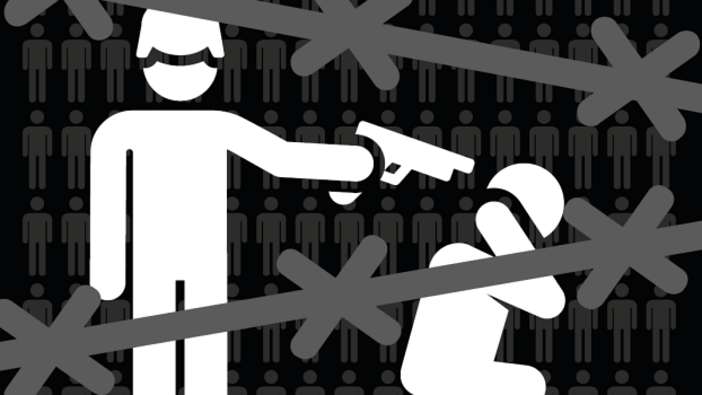
A counterrevolution by definition is a process whereby ruling elites fight back to regain control or to quash an uprising that threatens their privileges.
History has taught us that when victorious, counterrevolutions do not just take society back to square one. Rather, they take us back to square zero or below zero. All gains made in the fields of civil rights thanks to the collective action during the revolt are usually swept away. Situations deteriorate on almost all fronts.
Hossam el-Hamalawy is a journalist and activist with the Egyptian Revolutionary Socialists. He posts regular commentary and news updates on his blog, arabawy.org.
Egypt is no exception to this unfortunate law of history. Once on the path towards progressive change, ignited by the 2011 uprising, the July 2013 coup reversed the process.
The military, led by Abdel Fattah El-Sisi, unleashed the biggest massacres in the country’s modern history, crushing peaceful protests and strikes and destroying political parties, independent unions, community organizations, and youth networks.
Since the coup, at least 19 new prisons have been built to house the expanding population of political prisoners, which at present amounts to roughly 60,000 according to estimates by local and international rights watchdogs.
The initial targets of crackdowns were the Islamist opposition, both the reformists and radicals. Soon the scope of the regime’s dirty war expanded to include secular leftists, liberals, labour organizers, human rights defenders, journalists, bloggers, artists, students, foreign researchers, and social media users who post critical comments. The list goes on endlessly.
The majority are held on terror charges and loosely defined, yet draconian, charges of “spreading fake news”. This is coupled with an unrestrained expansion in the use of pretrial detentions as a systematic practice.
The regime’s severe repression naturally stems from panic felt by the Egyptian political and military elites, who for three years (2011–2013) saw their interests and privileges threatened by the revolution. The counterrevolutionary violence has in the meantime acquired two distinct patterns.
Deliberate Randomization of Violence
The security net has caught thousands and thousands of Egyptian citizens who are not connected to political movements, let alone involved in any dissident actions on the ground like spontaneous strikes and protests.
The detentions are not necessarily a “mistake” or a glitch in the system of policing. By unleashing mass random state terror, Sisi’s regime is behaving like foreign occupation armies involved in pacification of their colonies. In fact, the random targeting of citizens by the police in night patrols and on checkpoints, was increasingly used by Mubarak’s regime starting with the first dirty war in the 1990s. The post-2013 situation is replicating such experience on steroids.
Deliberate Targeting of the Organizational Cadres and Reserves
The two most serious waves of protests that erupted in the past years, in the autumn of 2019 and 2020, were largely spontaneous, or more accurately independent of any of the remaining political forces.
The security services acted in the usual heavy-handed fashion, rounding up thousands—most, if not all, unaffiliated with political organizations. The detainees were abused and kept in prison on bogus terror charges, but eventually released.
What made some eyebrows go up, however, was the mass campaign by the security services to round up veteran political activists. Not only were they uninvolved in the protests, but most of them also had already ceased to be active for years due to a number of reasons, most importantly demoralization.
In the eyes of Sisi’s security services, the targeting of political organizations’ active and retired cadres is not an “excess” or the result of “unprofessionalism”. Spontaneous protests are not enough to topple a regime. Despite the unprecedented outbursts, Sisi knows there is a ceiling these protests will not exceed on their own. It is the intervention of organizations (parties, unions, networks, movements) that could sustain mobilizations on the ground for longer times, articulate a political programme, and develop those protests into building a viable alternative to the regime. Sisi is taking no chances.
The level of Sisi’s popularity in 2021 cannot be compared to 2013–14, when genuinely large sectors of Egyptian society believed the rosy propaganda he was selling. However, disillusionment with Sisi will not necessarily be translated into anger on the streets at the present time or in the near future.
Spontaneous protests and strikes have been happening here and there, over a number of issues including housing, gentrification, and liquidation of state enterprises. The level of industrial actions and social struggles is still very low, and has a long way to recover to reach the pre-2013 years. However, an essential factor in such a recovery process also lies in the ability of dissidents to revive their networks, which have accumulated rich experience despite the defeat. This is why Sisi will continue depleting the opposition of its resources, cadres, and reserves.
The picture is bleak on so many levels in Egypt today compared to the high hopes ten years ago. But if 2011 was a product of a decade-long process of dissent accumulation, there is no guarantee Sisi’s counterrevolutionary regime will remain intact forever. The structural problems which ignited the revolt ten years ago—namely, police brutality and social injustice—have only deepened with the counterrevolution. Hence, the objective conditions for another revolt in the future remains.
One thing that can speed up this political recovery is campaigning as hard as possible to secure the release of as many political activists as possible. This is a task in which we expect the solidarity of international activists in Germany and elsewhere. We need you to lobby your governments into stopping military and security ties with Sisi’s regime, and to spread the word about Egypt’s political prisoners and help us lobby for their release.
